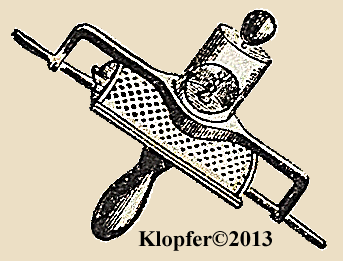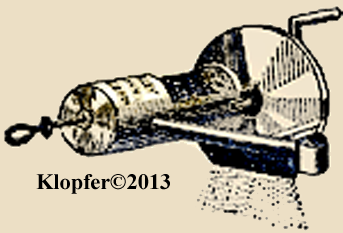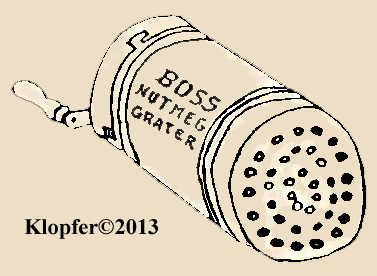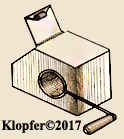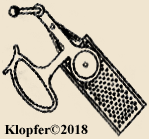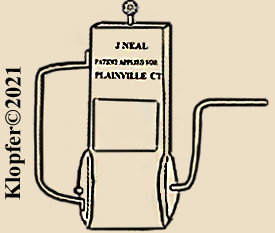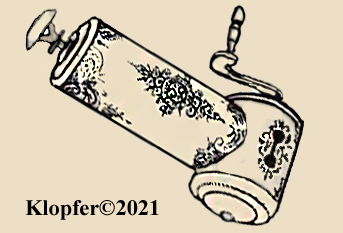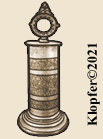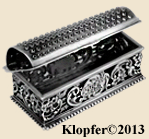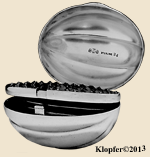 Click Me!
Click Me!
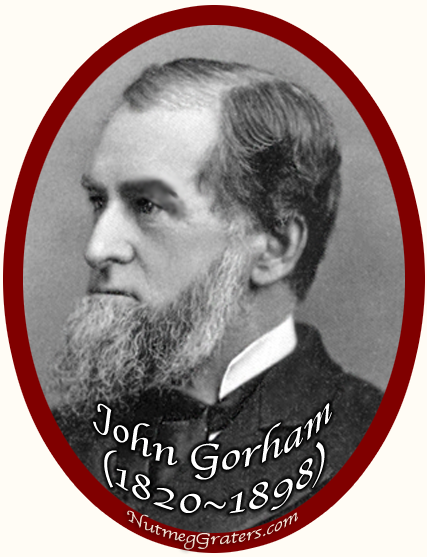
NutmegGraters.Com

- Home
- Featured Stories
- Picture Gallery
- Info.Wanted :
- Spurious Marks
- Trading Post
- Contact Our Site
- Wanted To Buy
[WELCOME: My articles published on NutmegGraters.Com and commercially (elsewhere) required many years of primary research, personal expense, travel and much effort to publish. This is provided for your enjoyment, it is required that if quoting my copyrighted text material, directly provide professionally appropriate references to me. Images are unavailable for copy. Thank you J. Klopfer.]
_______________________________________________________________________________________________________________________________________________________
Silver Nutmeg Graters By Gorham Mfg. Company
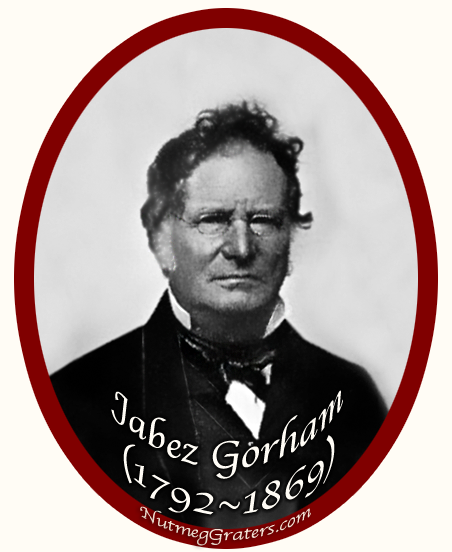 In 1818, Jabez Gorham (1792~1869) began business in a one room shop as a jeweler in precious metals. In 1831, he founded what later became the famous Gorham Manufacturing Company of Providence RI. Across many decades, periodic reorganizing among partners lead to the firm's various name changes.
In 1818, Jabez Gorham (1792~1869) began business in a one room shop as a jeweler in precious metals. In 1831, he founded what later became the famous Gorham Manufacturing Company of Providence RI. Across many decades, periodic reorganizing among partners lead to the firm's various name changes.
John Gorham (1820~1898) entered business with his father in 1841 and the firm became Jabez Gorham and Son. Jabez Gorham retired about 1847. John Gorham partnered with his cousin, Gorham Thurber (1825~1888) in 1850 as Gorham & Thurber. In 1852, the firm became Gorham & Co. when a third cousin Lewis Dexter (1829~1909) briefly joined the partnership. Between 1865 to 1961, the name Gorham Manufacturing Company was a giant in the world of silver.
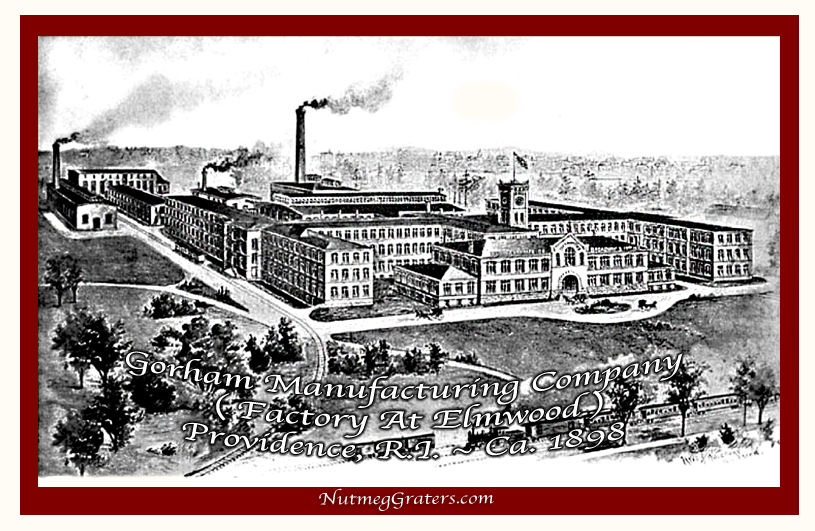
Unconfirmed forms of nutmeg graters, possibly (but most unlikely) by Gorham Manufacturing Company:
Although Gorham maintained abundant records, documentation for any of their silver nutmeg graters is lacking. Although unlikely, it is possible that Gorham & Thurber produced an ellipsoid (melon~shaped) nutmeg grater as early as 1850.
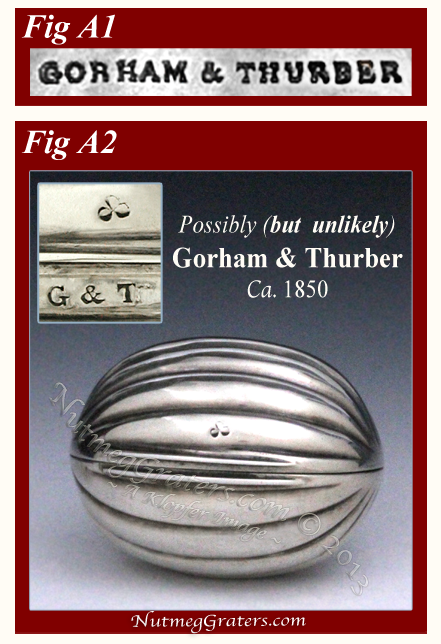
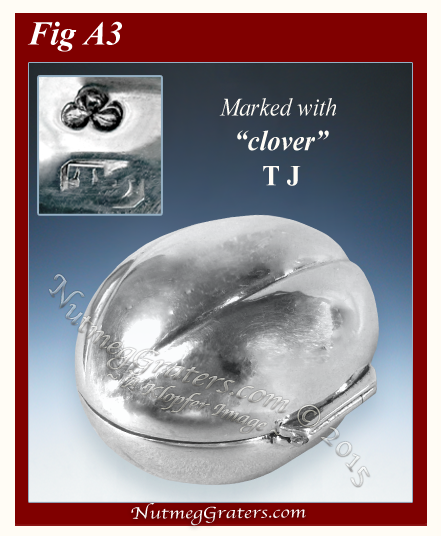 The origin of the ellipsoid shaped (melon~shaped) nutmeg grater dates to England in the 1830s. In 1829, John Taylor & John Perry became silversmiths in Birmingham England. They produced exquisite small silver items [including but not limited to: etuis, snuff boxes, vinaigrettes, caddy spoons, wine labels, etc.] Taylor & Perry produced nutmeg graters in a variety of styles. One confirmed Taylor & Perry ellipsoid nutmeg grater is date marked 1831, and an unconfirmed internet listing claims an another example dated 1832. The creation of this ellipsoid form seems linked to the emerging technology of its time. Other silver manufacturers soon duplicated this design which evolved as a common form, seen well into the 20th century.
The origin of the ellipsoid shaped (melon~shaped) nutmeg grater dates to England in the 1830s. In 1829, John Taylor & John Perry became silversmiths in Birmingham England. They produced exquisite small silver items [including but not limited to: etuis, snuff boxes, vinaigrettes, caddy spoons, wine labels, etc.] Taylor & Perry produced nutmeg graters in a variety of styles. One confirmed Taylor & Perry ellipsoid nutmeg grater is date marked 1831, and an unconfirmed internet listing claims an another example dated 1832. The creation of this ellipsoid form seems linked to the emerging technology of its time. Other silver manufacturers soon duplicated this design which evolved as a common form, seen well into the 20th century.
A possible (but unlikely) Gorham & Thurber nutmeg grater bears the mark "G & T" (Fig A2). The font closely resembles Gorham & Thurber's customary Times-New Roman lettering style (Fig A1). Located inside, the "G & T" mark was applied to the front edge of an internal rim; yet, an unidentified clover mark is applied outside on the front, top cover. According to Samuel Hough {Correspondence 2008: Samuel Hough, The Owl at the Bridge, Cranston, RI.}, "From the 1850s to about 1898, Gorham coded its hollowware with numbers;" thus, the clover mark seems a confusing enigma. Further drawing this mark into question as a Gorham item, a second example (Fig A3), bears the clover mark in combination with a maker's mark "T J", as well as a third example (not seen here) bearing a clover mark in combination with the maker's mark "JT" [sold at auction ROGO Auction 12/9/2006]. Finally, the "G & T" clover marked nutmeg grater is of a smaller scale in comparison with the later confirmed ellipsoid (melon~shaped) examples by the Gorham Manufacturing Company. Although additional study is required to confirm or refute this example (Fig A2) as being a product of Gorham & Thurber, it now appears a doubtful attribution. [Updated ~ January 2015]
About mid-century, the Gorham Manufacturing Company introduced its three symbol mark; using a lion (indicating silver), an anchor (to represent Rhode Island as largely an area of sea ports) and a capital G (as an abbreviation for Gorham). When improved silver refining technology impacted the silver industry, in 1868, Gorham MFG Co. became one of the first American firms instituting the "sterling silver standard" to replace its older "coin silver standard." Also beginning 1868, this firm instituted a system of "date mark" symbols to designate each year of fabrication. [NOTE: The "date mark" symbols with their corresponding dates are shown to the right; within the "Gorham Maker's Mark" chart.] In addition to a "date mark" (if used), products were usually marked with a Pattern Number, and the word Sterling.

 When attempting to assess production dates among Gorham nutmeg graters that have no date mark, it is useful to observe other features within the Gorham maker's marks to estimate the production date. In my early study, a melon form example appeared to be date marked "C" which would indicate a production year for the year 1870. However, by comparing among numerous other marks, a date of 1870 was determined to be erroneous. Notice that the earliest Gorham nutmeg grater maker's marks are "Incuse" marks, where the edge surfaces of the marking tool are entirely removed to leave a die with only the "inset" punch pattern, being an upright lion, anchor and letter "G" (in times font). The maker's mark with the melon form example in question uses a "Intaglio" mark, where the surround area was removed resulting in a relief or raised cameo punch pattern with the passant lion, anchor and letter "G" (Old English font). When comparing the entire series of maker's marks, it was determined that what was misidentified as a date mark "C" for 1870, can now be identified as an indistinct pattern-mark "№ 6", having a production date ranging from the late 1880's until 1898, after which Gorham added the letter "B" to all non-tablewear. With another different ellipsoid form example, Gorham's coding uses the letter "R" which is believed to represent "regular weight" (its date, "R", is unknown).
When attempting to assess production dates among Gorham nutmeg graters that have no date mark, it is useful to observe other features within the Gorham maker's marks to estimate the production date. In my early study, a melon form example appeared to be date marked "C" which would indicate a production year for the year 1870. However, by comparing among numerous other marks, a date of 1870 was determined to be erroneous. Notice that the earliest Gorham nutmeg grater maker's marks are "Incuse" marks, where the edge surfaces of the marking tool are entirely removed to leave a die with only the "inset" punch pattern, being an upright lion, anchor and letter "G" (in times font). The maker's mark with the melon form example in question uses a "Intaglio" mark, where the surround area was removed resulting in a relief or raised cameo punch pattern with the passant lion, anchor and letter "G" (Old English font). When comparing the entire series of maker's marks, it was determined that what was misidentified as a date mark "C" for 1870, can now be identified as an indistinct pattern-mark "№ 6", having a production date ranging from the late 1880's until 1898, after which Gorham added the letter "B" to all non-tablewear. With another different ellipsoid form example, Gorham's coding uses the letter "R" which is believed to represent "regular weight" (its date, "R", is unknown).
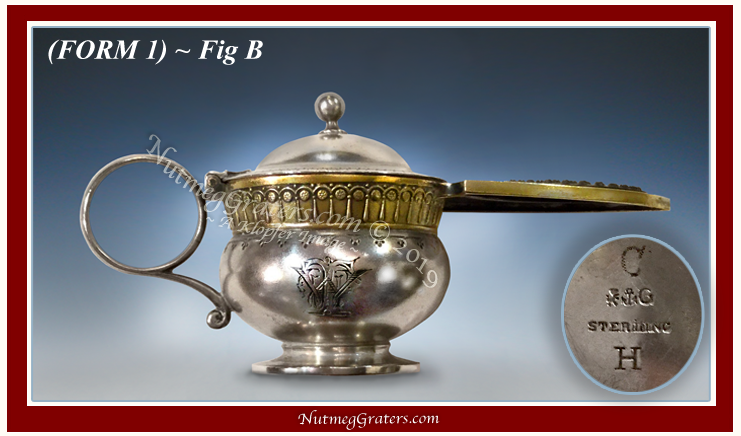
GORHAM MANUFACTURING COMPANY created at least six confirmed forms of silver nutmeg graters:
Two different examples of Gorham's most rare silver nutmeg graters are for the table; each is in the aesthetic fashion (an 1870 to 1880's American style characterized as elaborate, extravagant and unconventional in decoration; often with medieval adornments). Both examples were products in 1875 and linking them together, both have identical ball finials mounted on top of domed lids. Their design is unique in comparison to all other silver nutmeg graters and the styling stands in a class by itself. Both nutmeg graters are each likely "one of a kind".
FORM 1:
This rare table nutmeg grater (Fig B) consists of a covered bowl on Roman ogee style stand into which a whole nutmeg is stored; having a ring handle on one exterior side, opposed by an extended metal grate mount at the opposite side. A decorative "gold wash" was applied to the upper portion of the bowl, extending across the elongated-mount which houses the rasp (or grate). The cast design features a distictive guilded "rosette & pendant" banding, and the bowl is monogrammed "WHT". The nutmeg grater is date marked with an "H" indicating the year 1875 and the Gorham maker's mark is incused (Fig B2) [SEE: Chart to the right].
.png)
FORM 2:
This basket form table nutmeg grater (Fig C1) stands upon an elegant circular base. The ornamental band decoration consists of a foliate leaf scroll and encircles the container's top edge. The covered bowl is sizable to store three whole nutmegs. Carried by its silver-wire bail, the handle is secured using three twists of a rustic silver coil. Attached under the lid is a fixed iron grate (Fig C2). The nutmeg grater is date marked with an "H" representing the year 1875 and the Gorham maker's mark is intaglio (Fig C3) [SEE: Chart to the right]. Notice the symbol over the maker's mark; the significance of these double slashes remains unknown.
F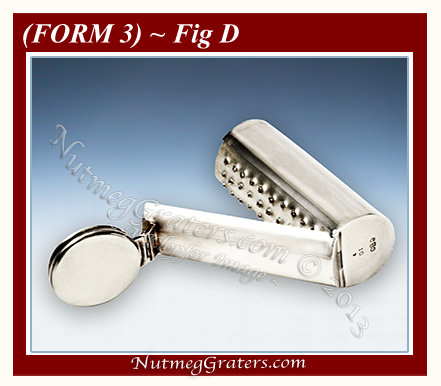 ORM 3:
ORM 3:
In 1895, Gorham produced their neoclassical cylinder nutmeg grater with drop~away, double hinged covers (Fig D). The maker's marks on this (Fig D2) consist of the (right~facing) passant lion, the anchor, and the letter "G" (in an Old-English font), the pattern number is "10", and the half-moon symbol represents the production period as 1895. Notice, the word "sterling" is absent.
These nutmeg graters are rare, but not unique. Three are known to this author, indicating that Gorham likely created them as a small batch lot. The silver plated grate is removable, and is tightly friction fit suspended in place against two internal silver bands.
FORM 4:
In the following year 1896, an hour-glass form silver nutmeg grater with drop~away, double hinged covers (Fig E). The maker's marks on this (Fig E2) consist of the (right~facing) passant lion,
the anchor, and the letter "G" (in an Old-English font), the pattern number is"15", and the scallop-shell symbol represents the production period for 1896. Marked "sterling", it is also marked "& other metals". This nutmeg graters is very rare. Similar is structure to (FORM 3 ~ Fig D), this example also has a silver plated grate that is removable, and is tightly friction fit suspended in place against two internal silver bands.
FORM 5 [ Melon Style A (Fig F3) & Melon Style B (Fig F5) ]:
For decades, Gorham Manufacturing Company produced an ellipsoid nutmeg grater in the shape of an eight-lobed melon. Based on outward appearances, all are identical and indistinguishable from each other (although the rear hinge designs sometimes vary) (Fig F1 & F2). While some examples bear specific "date marks", most do not. Regarding undated examples, differences in the design styling among Gorham maker's marks contribute as circumstantial corroboration to establish a period of manufacture.
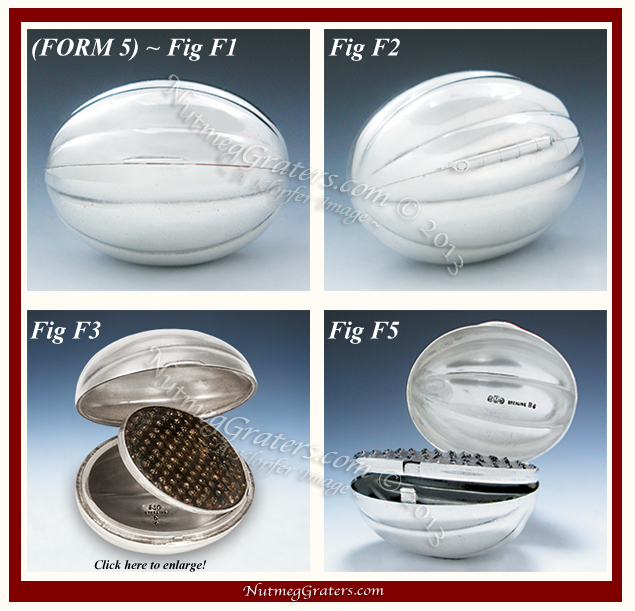
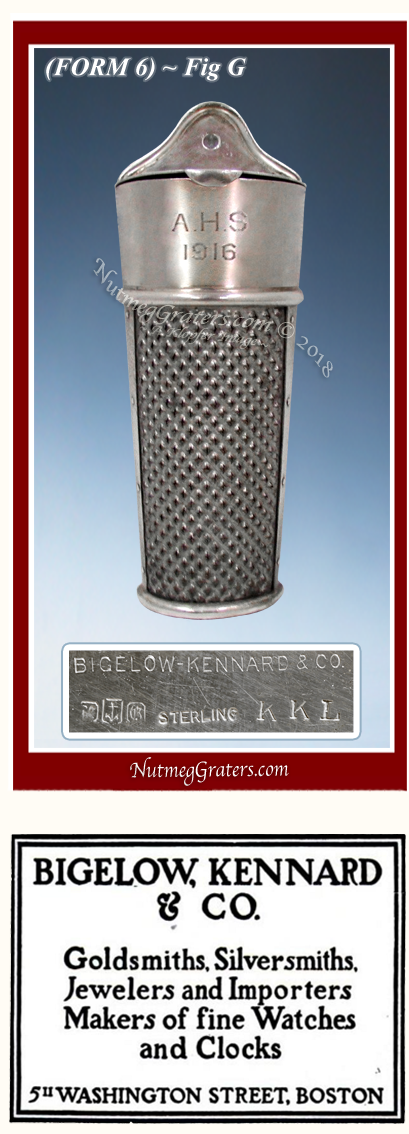
There are two sub-types, distinguishable by the method in attachment of the internal grate:
SUB-TYPE 1). The Inside Right~Sided Hinge Style (Fig F3):
The earliest ellipsoid nutmeg grater in this study was determined using Carpenter's index of "Gorham Marks" (Gorham Silver, page 228, Fig 12). Charles H. Carpenter writes: "Flatware and small pieces of hollow ware of the 1850-1865 period occasionally made use of a lion that appears to be standing straight up on its rear haunches" (page 227). The lion-anchor-G mark shown by Carpenter is identical to the mark on this nutmeg grater (Fig F4 ~ SEE: "Gorham Maker's Marks" Chart: Above Right). However, in contradiction to Carpenter's dates, this nutmeg grater is also impressed "sterling," probably indicating a later fabrication; not earlier than circa 1868.
This Gorham nutmeg grater features the pattern number "5" and has two hinges (the covers are
hinged in back and the grater plate is hinged separately on the right side). Notice that below the
pattern number "5" is a "round cypher" mark (Fig F4); which may be the "date mark O"
and thus, suggestive of an 1882 manufacturing date. [SEE: Enlargement].
This Gorham ellipsoid (melon) nutmeg grater with pattern number "5" is very rare.
SUB-TYPE 2).The Inside Rear Hinge Style (Fig F5):
The second melon configuration, usually marked using the pattern number "6", is constructed where both top and bottom covers, plus the internal grate, pivot around a single rear hinge. This study shows "date marked" examples for 1890, 1891, 1898, 1903, 1908 and 1909. [We remain interested to photograph examples with additional "date marks" from our viewers; please keep us in mind!] According to Samuel Hough {Correspondence 2008: Samuel Hough, The Owl at the Bridge, Cranston, RI.}, "after 1898, and until 1932, Gorham used an 'A' prefix for sterling silver tableware and the 'B' prefix for non tablewares." Examples within this study conform with "B6" marked on the nutmeg graters bearing date marks after 1898 [and probably when Gorham discontinued the use of their "date mark" symbols on these nutmeg graters, being after 1910].
Most later Gorham melon shape nutmeg graters were marked using a single row "lion-anchor-G STERLING B6" (Fig E5), with the "B" indicative of a manufacturing date of 1898 or later. Although none of these Gorham nutmeg graters are common, examples with the single row mark are more available for collecting. If collectors continue to search for one, sooner or later, they can find an example for sale.
FORM 6:
About 1916, the Boston jeweler and silversmith firm Bigelow, Kennard & Co subcontracted Gorham to manufacture a silver box-grater for nutmeg [5¼" H. X 1⅞" W.] (Fig G). John Bigelow & Co was first listed as a Boston silversmith about 1825 expanding to include brothers Alanson & Abraham Bigelow in the 1830's, and Martin Kennard about 1845. Between 1863 until it closed in 1972, the company name was Bigelow, Kennard & Co. Throughout its existence, the company was well advertised in local Boston publications (the example shown above right is an ad from 1914). These nutmeg graters are very rare.
SUMMARY:
Although the exact date when Gorham introduced or discontinued their ellipsoid form nutmeg grater remains uncertain, it's production period spans more than 30 years. Other forms of Gorham's nutmeg graters are very scarce.
The Gorham Buildings for retail sales. 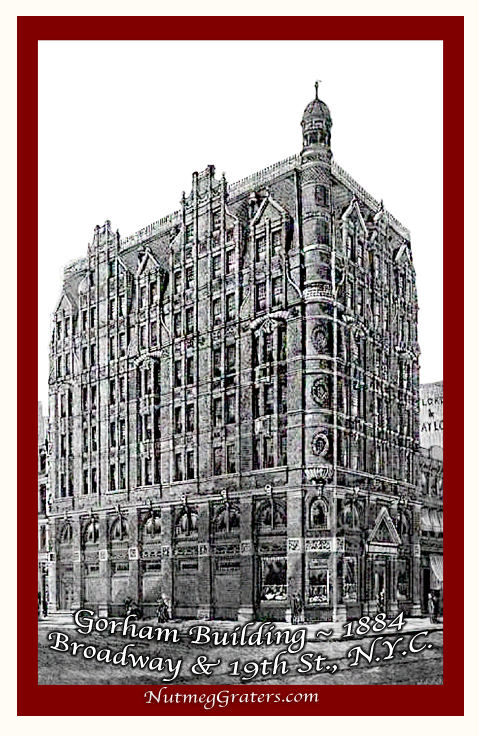
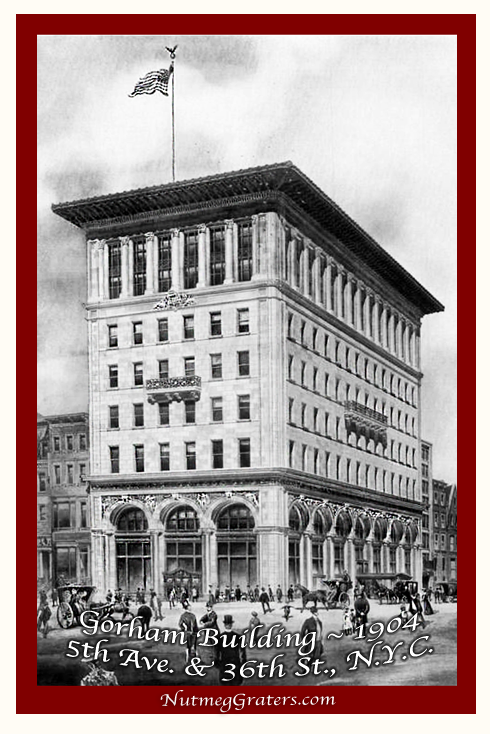
[KLOPFER article © September 2013 { © with updates January 2015; January 2019; September 2020 & January 2022} ]
